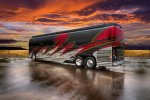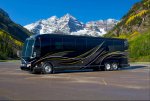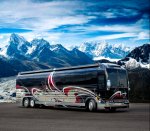Silverado08
Observer
Hi Silverado,
I guess I need to ask you: do you think that the thousands of retired Americans who are driving around in 45-foot Class A motorhomes, and towing TOADs, are foolishly impractical? Did they waste their money on a Class A? Are the companies that build these large motorhomes in the United States, "impractical"? Are these companies that should now be bankrupt? And if they are not now bankrupt, and if they are still selling large Class A motorhomes that are 45 feet long, then what does this say? Have you ever wondered about who buys such large motorhomes, and why?
Yes, the TerraLiner is intended to be driven on roads that are also driven by trucks and buses. It is not intended to be driven on small dirt tracks that can only be driven otherwise by Jeeps that have 4-wheel drive. The TerraLiner is not intended for rock-crawling. But saying that the TerraLiner will only be able to drive super-highways is a gross exaggeration. It's a "hyperbolic" statement. Big buses and trucks will drive smaller two-lane streets and highways all the time, as do American Class A motorhomes that are towing TOADs.
The TerraLiner has big tires mainly so that it can enter a farmer's field without a problem, and then leave again. As someone remarked earlier in the thread, big tires and all-wheel drive on expedition motorhomes are there largely so that the vehicle can drive the last 200 feet to its campsite. Otherwise, like all other vehicles, for 95 % of the time even expedition motorhomes will use regular roads.
However, the big tires and very robust chassis frame are also there so that the TerrraLiner can drive large gravel highways like the Tanami Road in Australia, or similar highways in Asia and Latin America. Not all roads intended to be used by large trucks and buses are paved. In lots of countries they will put in a road that's big enough and wide enough to be used by trucks and buses, but it will be gravel, and not that well maintained. So it will be very corrugated, and any kind of ordinary motorhome with small tires and a weak chassis frame will not be able to handle it. Have you seen videos posted earlier in the thread of the Tanami Road? It has the width of superhighway, and yet it is gravel and heavily corrugated:
Notice the size of the tires used by the vehicles that travel the Tanami: they are not small. However, as I made clear, the tires in the schematic of the Panther are actually over-sized; they are a particular type of Fire-and-Rescue tire that is 1.38 m in diameter. The TerraLiner will not carry such large tires. Rather, like egn's Blue Thunder and similar-sized expedition motorhomes, the TerraLiner will carry Michelin XZL 14.00R20 or 16.00R20 tires, tires that are 1.258 m and 1.342 m in diameter, respectively; or the equivalent, for instance a specialized sand-tire of the same size. To maximize the amount of volume and height available for the camper box, as recommended by egn very early on in the thread, the TerraLiner will probably carry Michelin XZL 14.00R20 tires.
Before you object further, have you ever taken a look at the Unicat or Actionmobil websites? Have you actually checked to see the size of the tires that their 6x6 motorhomes carry? Michelin XZL 14.00R20 tires seem to be the standard, preferred size.
Also remember that a large tire-radius provides good under-axle clearance. One of the problems that smaller vehicles with smaller tires encounter when they drive bad roads like the Tanami, is that the ruts in the road were created by large trucks with big tires. If smaller vehicles try to follow these ruts with their small tires, their center-lines will get stuck on the mounds or ridges between the ruts. This kept happening to the vehicles that participated in Stephen Stewart's 2003 motorhome expedition through China and Tibet:
See http://www.xor.org.uk/travel/china2002/ , http://www.xor.org.uk/travel/china2002/20021010.htm , and http://www.xor.org.uk/travel/china2002/20021012.htm . This is why smaller expedition motorhomes with small tires will usually need to have portal axles, so that they have sufficient center-line clearance. Whereas in a larger vehicle it makes more sense to just have large tires.
If these observations about the problem of ruts are new to you, well, they should not be. The problem of ruts has been discussed before in the thread at length, so you may simply need to re-read some of the earlier posts in the thread.... Here I am generously assuming that you have already read all of the thread!..:sombrero: ...
For instance, the TerraLiner is not intended to be a traditional kind of motorhome that uses RV parks extensively, and it is also not intended as a motorhome that stays one week here, another week there, and that travels quickly between places. Rather, the TerraLiner is intended as a motorhome/mobile house that will drive from point A to point B, and then settle in for 3 months; and then it will drive from point B to point C, and settle in for another 4 months; and then it will drive from point C to point D, and settle in for 2 months. And so on, all the time glamping primarily in farmer's fields. Think of the TerraLiner as a mobile house, and not a motorhome, and you might understand the concept better. Or remember that I have very clearly stated the the TerraLiner is intended for "slow travel", and not for "fast travel".
Again, the TerraLiner itself is for sojourning, not exploring. The TerraLiner arrives at point B, it enters a farmer's field, and then it stays put. The TOAD does the exploring, not the TerraLiner. And the TerraLiner will be able to "dry camp" in a farmer's field for 3 months, because it will be an unusually "autonomous" motorhome, in terms of power, water, and sewage. It will not need the hookups of an RV park, because it will incinerate its sewage, and it will make its own water.
This is a very simple idea. Once you imagine the TerraLiner as an unusually "autonomous" mobile house, lots of possibilities open up. You need to imagine the TerraLiner as traveling in a way that is different from the kind of traveling that you are simply assuming as given. You also need to remember the target-market: retired old people, with time on their hands. Not middle-aged people or young people who want to zip around, traveling from one country to then next every 10 days. Furthermore, the type of traveling that the TerraLiner will do is exactly the kind of traveling that retired people already do with their Class-A motorhomes in the United States. They will go from point A to point B, and then settle in for a number of months, using their TOADs to explore, not their large Class-A motorhomes. The type of traveling that I am envisioning here is not new, even if you are personally not familiar with it. The only part that's new is the idea that the TerraLiner will be able to glamp on farms instead of RV parks, because it will be unusually autonomous.
The reason why there is a market for 45-foot Class A motorhomes in the United States, is that when people start imagining living in a motorhome full-time -- for decades and not just a few months, and not just for one year -- they realize that living space will be important to them. Please read the discussion about what it's like to live full-time in a motorhome at https://www.reddit.com/r/AskReddit/comments/1ujkeh/people_who_have_lived_in_rvs_for_an_extended/ , and please read post #2229 at http://www.expeditionportal.com/for...w-6x6-Hybrid-Drivetrain?p=1990959#post1990959 . Have you personally lived in a motorhome for a year? Have you lived in a small motorhome for a year with a "significant other", i.e. your wife or girlfriend?
"Impractical" is a very nebulous word, a word that is not much use when discussing different sizes of motorhome. "Impractical" does not have any real content or meaning, and amounts to nothing more than an emotive statement to the effect, "I personally don't like it." What is "practical" for a middle-aged person who only wants to use a motorhome on weekends, or for three-week trips, or for one-year on a round-the-world trip, is not "practical" for a retired couple who want to live in their motorhome full-time for at least a decade. Please read the thread that I just referenced. For people who have actually tried living in motorhomes full-time, having more living spaces is very practical. The thread just referenced is also interesting in so far as a number of participants talk about being forced to live in small motorhomes teenagers, because their parents split up, or because their parents were poor. They absolutely hated living full-time in a small motorhome, and they write that they never, ever want to live in a small, cramped motorhome ever again. The heartfelt hatred they express towards living full-time in a small motorhome is vivid, very real, and makes for sobering reading. Anyone who wants to comment on the proposed size of the TerraLiner should first read that thread. Again, see https://www.reddit.com/r/AskReddit/comments/1ujkeh/people_who_have_lived_in_rvs_for_an_extended/ .
As for the other issues you brought up, yes, of course I have been thinking about spare tires (they go in -- or on -- the TOAD garage, where there will be ample room), and of course I have been thinking about breakdowns and servicing. Which is precisely why I have been specifying a serial hybrid drivetrain and two generators for redundancy. Have you read all the posts in which this has been discussed?
Most recently I posted about the basic problem that there are no truly "global" vehicles. Finding parts and service even for a truck manufactured by a company with significant global presence like Mercedes, Volvo, or MAN may prove difficult in many places. MAN does not seem to have any presence in North America, for instance, and no major European truck manufacturers have much presence in China or India. Presumably they won't have much presence in Indochina either, where I would guess that the preference might be for much cheaper, Chinese-made trucks. So the idea that a more conventional drive-train will magically solve the problem of parts and service worldwide, is I think a bit naive and optimistic. Especially in this day and age when all new engines are loaded with complex electronics. I could be wrong about this, but I would need to hear convincing arguments to the contrary. For instance, someone would have to show me a service map for Volvo, MAN, or Mercedes trucks that truly covers the entire globe, and especially Asia. See posts #2221 to #2224, beginning at http://www.expeditionportal.com/for...w-6x6-Hybrid-Drivetrain?p=1990846#post1990846 . ...
Here are pages from a recent Mercedes PDF, which sum up Mercedes' truck markets worldwide -- see https://www.daimler.com/documents/i...r/daimler-ir-brochurefactsandfigures-2014.pdf :
View attachment 321819 View attachment 321820 View attachment 321825
View attachment 321826 View attachment 321827 View attachment 321828
Unlike MAN, Mercedes does have a significant presence in North America, because it owns FreightLiner. But it would be interesting to find out whether this will help one much if one has an expedition motorhome built on top of a European COE Actros truck, and one's Actros truck needs servicing in the United States. FreightLiner trucks are very different from the kinds of trucks Mercedes sells in Europe, if only because at a bare minimum FreightLiner trucks are CBE, cab-behind-engine.
Mercedes also seems to have a presence in Indonesia, which is interesting (and a bit surprising), and it has a new venture called "BharatBenz" in India -- see https://www.daimler.com/products/trucks/bharatbenz/ . But the number of trucks sold by BharatBenz in India is still minuscule in comparison to the number of trucks sold in India by Tata Motors (59.3 % of Indian market share), or Ashok Leyland (25 % of Indian market share):
View attachment 321818
Furthermore, aside from two joint-ventures, Mercedes trucks does not seem to have any significant presence at all in Russia or China. And if a Mercedes truck is not a truly "global" vehicle from the point of servicing, then no conventional ICE truck is.
Also, please remember the TerraLiner's target demographic, and please realize that if you are middle-aged, and if you are not yet retired, then I am not designing the TerraLiner for you. So in that sense, it's kinda irrelevant what your own, personal preference regarding motorhome size might be....:costumed-smiley-007... I am designing the TerraLiner with a very specific demographic in mind. Remember that when designers create something, they always have a very specific target-market in mind. We don't design for everyone. Rather, we design with a specific group of people in mind. The mere fact that different sizes of motorhome exist, should make this self-evident. If there were just one "ideal motorhome" size for everyone, then motorhome manufacturers would create and sell just one size of motorhome. That they do not, should tell you something.
I don't really understand why such an obvious point is not clear to some thread participants, and having to repeat it is a bit tedious, although perhaps also necessary. I hope that the above arguments have been clear enough. But also please note that I have made all of these arguments before, earlier in the thread. None of these arguments should sound new to you, if you have actually read the thread.....
All best wishes,
Biotect
Have you ever met or know anyone who would be interested in driving this type of vehicle the way you envision?
Those big American buses are still limited to good highways so yes they would be very impractical nay impossible to drive anywhere else..especially around the world thru some dirt roads..
Like I said the 6x6 itself is nice but draging another 6 axle heavy trailer is way impractical in bad terrain..can you imagine trying to back this up if needed?
Building your imaginary terra mobile is very easy imo,,with enough money,,the question is will anyone want it?
Wouldn't someone already build this if there was demand?
Those few custom built are very few and far between. .but hey its your dream so don't mind me criticizing lol..
We are just sharing ideas yes
I'm retired and like to travel at least once a year,unfortunately ,I'm too busy with my automotive project presently..plus I plan to build another RV my way too..and it doesn't have to be huge to be comfortable..
Last edited:




















